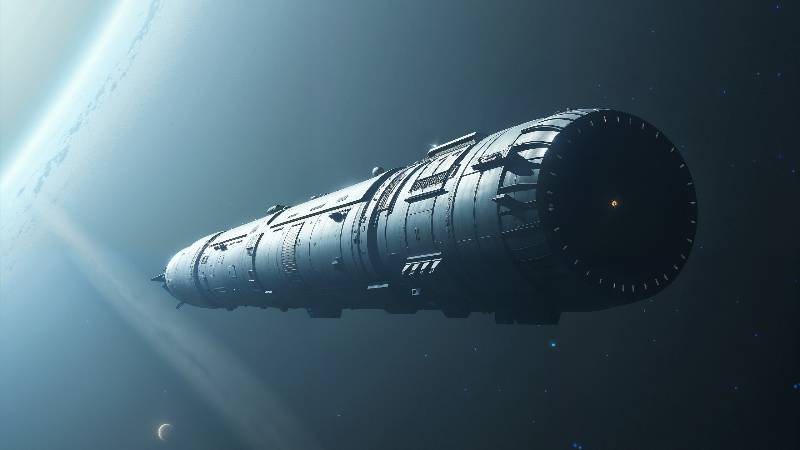An Italian interdisciplinary team has unveiled “Chrysalis,” a first‑place design in the Project Hyperion competition that imagines a multi‑generational starship capable of ferrying a self‑sustaining human society to the Proxima Centauri system in about 400 years.
The concept targets Proxima b, an Earth‑size, potentially habitable exoplanet 4.24 light years from Earth using near‑future technologies and a holistic socio‑technical architecture that blends propulsion, habitat engineering, governance, and culture.
The Big Idea: A Traveling Civilization
Chrysalis is conceived as a colossal, modular “worldship” approximately 58km long, designed to host generations of travelers in a rotating habitat that provides artificial gravity, food production, manufacturing, and social life for centuries. Its nested, Russian‑doll‑like shells layer farms, gardens, communal spaces, homes, and warehouses around a central core, optimizing protection, redundancy, and maintainability over time. A signature feature is the forward Cosmo Dome, a vast microgravity recreation and observation space that doubles as a psychological well‑being anchor during the multi‑century journey.
Mission Profile and Performance
- Destination and distance: Proxima Centauri b in the Alpha Centauri system, roughly 4.24 light‑years (about 40 trillion km) from Earth.
- Timeline: About 1 year of acceleration, around 400 years cruise, and about 1 year of deceleration to arrive in the target system.
- Speed goal: approx 0.1c (one‑tenth the speed of light), fast enough to complete the crossing in roughly four centuries.
- Capacity: Designed for up to 2,400 people, with steady‑state population management around 1,000-1,500 to sustain closed‑loop systems and social stability.

Propulsion and Power
The design centers on a Direct Fusion Drive (DFD) concept using helium and deuterium isotopes to provide both continuous thrust and onboard electrical power, which is an unproven but actively explored propulsion pathway that could enable high‑delta‑v missions without impractically large propellant masses.
While fusion propulsion has not yet been demonstrated at interstellar scales, Chrysalis adheres to the competition’s near‑future technology brief and frames DFD as a plausible route to 0.1c within a multi‑decade development horizon.
Architecture for Centuries
- Rotational gravity: Concentric, rotating shells generate artificial gravity to mitigate long-term physiological decline.
- Life support and agriculture: Integrated, closed‑loop ecosystems distribute food, water, air, and waste handling across modular layers to compartmentalize risk and allow phased upgrades.
- Resilience by design: The nested structure enables maintenance and replacement over centuries, with in‑space manufacturing planned to extend the ship’s lifespan beyond initial build‑out.
- Cosmo Dome: A dramatic, panoramic microgravity zone at the bow for recreation and morale, highlighted by the judges as both functional and psychologically restorative.
Society, Governance, and Culture
- Population strategy: Dynamic demographic management maintains sustainable resource use while preserving genetic diversity and social cohesion across generations.
- Governance: A human‑led system augmented by AI aims to preserve knowledge, assist decision‑making, and buffer against cultural drift or discontinuities over long timescales.
- Culture and continuity: Lifelong education, curated archives, and shared rituals are embedded to transmit skills, identity, and mission purpose from one generation to the next.
Training on Earth: Antarctica as a Dress Rehearsal
A distinctive proposal is an extended analogue program: 70-80 years of phased isolation and operations training in Antarctica to stress‑test social dynamics, logistics, and psychological health in a remote, self‑contained environment before committing to launch. This long-baseline rehearsal would refine governance, education, emergency doctrine, and maintenance practices under real constraints.
Why It Won
Project Hyperion’s jury cited Chrysalis for its system-level coherence, pragmatic structural approach, credible radiation protection measures, and the depth of its planning, from in‑space manufacturing to crew preparation while also praising the design’s cinematic clarity and evocative worldship aesthetics.
The competition publicly announced Chrysalis as the 1st‑place winner alongside Polish and Malaysian runner-ups, underscoring the project’s standout integration of engineering and social architecture.
Reality Check: Challenges Ahead
- Fusion readiness: DFD remains pre‑demonstration for spaceflight, much less interstellar missions, and would require major breakthroughs in confinement, power density, reliability, and long‑duration operation.
- Centuries‑scale resilience: Micrometeoroid protection, radiation mitigation, closed‑loop ecosystem stability, and multi‑generational social continuity represent unprecedented engineering and sociological challenges.
- Ethics and consent: Designing a society whose descendants inherit a mission raises complex questions in rights, governance, and cultural autonomy that must be addressed up front.
The Significance
Chrysalis reframes interstellar travel as a civilizational undertaking rather than a pure propulsion problem, demonstrating how habitat architecture, governance, culture, and training can be as mission‑critical as engines and shielding.
Even if never built, its architecture and methods could inform nearer-term deep‑space habitats, closed‑loop life‑support, and long‑duration crew operations in cislunar space and beyond.


Discussion
Start the conversation
No comments yet
Be the first to share your thoughts on this article. Your insights could spark an interesting discussion!